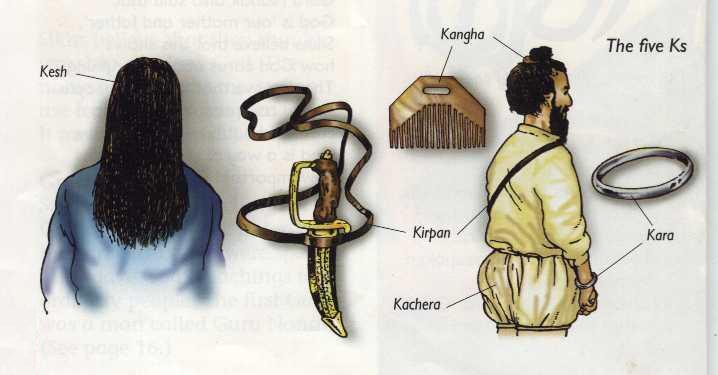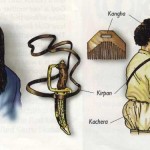
Sikhism is one of the oldest and very powerful religions of the Asian subcontinent. In this post we will discuss all about Sikhism especially the five Ks of Sikhism. The Five K’s of Sikhism are also called the Panj Kakars. The Sikhs need to be baptised liked the Christians. Only when they are baptised they form a part of the Sikh Khalsa.
5 K’s of Sikhism
As soon as a person becomes a sikh he or she adopts the Five Ks of Sikhism. These five items are iconic symbols and are the identity of the Sikhs. They have a deep religious and spiritual significance. Most of the Sikhs even today follow the Five k of Sikhism. The Five k of Sikhism can be considered as a uniform that is given to the Sikhs. The tradition of the Five k of Sikhism was started by Guru Gobind Singh. It was started in the year 1699 on the Baisakhi day. Guru Gobind Singh was the tenth Guru of the Sikhs.
All Aouut Sikhism: The Five Ks:
- Kesh
- Kangha
- Kachera
- Kara
- Kirpan
Prohibited Acts in Sikhism
The khalsa also says that the true Sikhs should stay away from the following:
- Sex outside marriage is prohibited and is considered as a sin.
- A true Sikh should not have meat.
- The consumption of alcohol, tobacco and other in toxicants are completely not allowed to a Sikh who has become a part of the Khalsa.
The detailed explanations of the Five k of Sikhism are discussed below:
- Kesh – this K stands for hair that must be left uncut. Traditionally all male and female members of the Sikh community do not cut their hair. The male are not even supposed to cut the beard. This is a proof of the natural state of the person. This symbolises devotion to the god. However, some of the Sikhs today prefer to trim the beard and also cut the hair to some extent. In the olden days the males would allow the beard to grow freely. This was symbolic of the fact that things should go on as wished by god and should not be changed by using unnatural sources. In the countries like United Kingdom men prefer not to grow the hair and wear the turban considering the violence that has been seen off late against the Sikhs. The western world does not understand the custom and they consider the Sikhs as terrorists or Muslims. This is one reason why this tradition is slowly dying. However, in India the men and women still continue to follow the tradition of Five k of Sikhism.
- Kangha – the second in the list of the Five k of Sikhism is the Kangha. This is a wooden comb that was used by the Sikhs to brush the hair. This hair of the Sikhs that is allowed grows without control. The Kangha is used to keep the hair tidy and clean. The Guru Govind Singh was very particular about cleanliness. To ensure this cleanliness the Kangha was used by the Sikhs. The Sikhs must wash the hair in the morning. After washing they must comb the hair. After the hair dries it must be tied into a topknot. The Kangha must be placed in this topknot and covered with a turban. The Kangha is symbolic of discipline in all the aspects of life.
- Kachera – We will now move on to the third of the Five k of Sikhism. It is called the Kachera. This is a short trouser that the Sikhs who are a part of the Khalsa must wear. This is like a short undergarment that the Guru Govind Singh wanted the followers of Khalsa to wear. It was a part of the uniform that he planned for the Sikhs. The aim was to differentiate between the Hindus and the Sikhs as the Hindus generally wore a dhoti that would cover the whole legs. Some said the Guru Govind Singh came up with the idea of the Kachera so that the Sikhs could move around easily and run in the battles. Some of the Sikhs say that the Kachera is a sign of Sikh modesty. The Sikhs are generally a peaceful community who were told to fight by the leaders only when their religious sentiments were hurt. The Sikhs have followed this commandment quite strictly.
- Kara – The fourth K in the list of the Five k of Sikhism stands for Kara. The Kara is a bangle that is made of iron or steel it is worn by the Sikhs. This is worn in the right hand by both men and women. The steel or iron is the symbol of strength and the circular shape of the Kara signifies unity and eternity. This is because a circle does not have a beginning or an end. The Sikhs belive that god is eternal and infinite. They feel that god is a common force and all the religious beliefs are paths that lead to the same power we know as god. The circular shape of the Kara connects the Sikhs to the god.
- Kirpan – The last in the list of the Five k of Sikhism is the Kirpan. The Kirpan is a small knife that you will see with Sikhs all the time. This is worn by the members of the Khalsa be it male or female. The Sikhs consider this as a sword they do not want people to term it as a dagger or a knife. The daggers and knifes are used for violent purpose the purpose of the Kirpan is not violent. It is a symbol of courage. It proves that the Sikhs are brave enough to sacrifice their lives for the sake of their religion. It is a symbol of the undying faith that the Sikhs have in their god. The Guru Govind Singh said that the Kirpan must be used only to defend the weak. It should not be used for any other reasons. He also said that the Kirpan is the symbol of courage. It is meant to fight the weakness within. The Kirpan can be used for self defence by the Sikhs. The Kirpan must be used to fight the weakness of character that we have within us. So next time you see a Sikh with a Kirpan you will understand the deeper meaning of carrying this along.
The Five k of Sikhism is a must to understand the value system of the religion. If you are planning to take up the religion then you must understand all these points about Sikhism well enough. This will prepare you to decide if you want to follow to take up the religion and become a part of the Khalsa. The commitment made by a true Sikh is not easy and must be followed with full dedication.
The reality of the Five k of Sikhism is indeed very interesting and spiritually very deep. Perhaps we all no matter what religion we belong to can learn something from the Five k of Sikhism. This is what makes the faith of Sikhism so universal.
